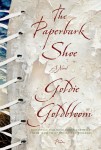How important is character to a novel? You can find an answer in what comes to mind when you hear names like Holden Caufield, Jay Gatsby, Rabbit Angstrom or Atticus Finch. Gin Boyle Toad, the central character of Goldie Goldbloom’s The Paperbark Shoe, may never rank up with those names. She is, though, one of the most memorable fictional characters I’ve encountered in a long time.
 Gin and the other central characters in her story are prisoners, literally or metaphorically, and for reasons largely beyond their control. Born an albino, Gin’s life has been one of indelicate stares at a freak. Her life is to some extent almost Dickensian. Although raised in a well-to-do family in Perth, Australia, educated in a private school and trained as a classical pianist, she is ultimately abandoned and institutionalized by her stepfather. She is rescued by Toad, a dwarfish, illiterate farmer who falls in love with her when he sees her playing the piano. They marry and Toad takes her to his homestead in remote, sparsely populated western Australia.
Gin and the other central characters in her story are prisoners, literally or metaphorically, and for reasons largely beyond their control. Born an albino, Gin’s life has been one of indelicate stares at a freak. Her life is to some extent almost Dickensian. Although raised in a well-to-do family in Perth, Australia, educated in a private school and trained as a classical pianist, she is ultimately abandoned and institutionalized by her stepfather. She is rescued by Toad, a dwarfish, illiterate farmer who falls in love with her when he sees her playing the piano. They marry and Toad takes her to his homestead in remote, sparsely populated western Australia.
Gin’s albinism and Toad’s small stature and crude manners alone are enough to make them the talk of the country folk who also eke out a living battling the elements in this often hardscrabble region. Although they have two children — a third, an albino, died — this is a marriage based on needs other than love. Gin and Toad “didn’t have anything in common besides the basic need for companionship and a joint wish for protection from the eyes and comments” of area residents. Yet the comments will turn to scandalous gossip in 1943 when two Italian prisoners of war, Antonio and John, are assigned to work on their farm. In fact, some 18,000 Italian POWs were sent to Australia between 1941 and 1947. To alleviate the labor shortage caused by the war, many were assigned to work on isolated farms and ranches.
Gin’s perspective, which she admits are slanted at times, describes the growing feelings and alienation that arise among the four as they get to know Antonio and John. In a number of ways, these include “thoughts that must be murdered before they are born.” Various events increase the locals’ perception of scandal, including Gin naming her and Toad’s new son Anthony, even though she was already pregnant when Antonio and John arrive. Goldbloom does not rush the reader through these developments. Gin’s voice patiently unveils not only these relationships but the story of her life before Toad. Throughout, we get a measure of the strengths, flaws, hopes and dreams of each of the four and how the outside world defines and treats them based on their physical attributes or political status.
The Paperbark Shoe is marked by at times exquisite writing and phrasing. Gin’s description of Antonio, a shoemaker by trade, fitting her for shoes he is making for her family is as sensual as a real love scene. And as Toad performs at a talent show in the nearest town and inadvertently exposes himself, she describes how each movement “nails me to the bench, crowns me with barbed wire, [and] stabs me endlessly in the eyes with the bayonet of his exposure.” Goldbloom, a native of western Australia who now lives in the U.S., uses her familiarity with the land, the climate, the culture and native flora and fauna to create sense of place that becomes almost a character itself. Yet Goldbloom truly excels in Gin’s descriptions of an internal landscape, one that unfolds as she ponders the emotions and ramifications of her past, present and potential future.
Goldbloom’s style helped the book win the 2008 Association of Writers and Writing Programs (AWP) Novel Award. That led to it being published in the U.S. last year in hardcover as Toads’ Museum of Freaks and Wonders. This new paperback edition returns to the title of the original Australian publication in 2009 and is arriving in larger numbers than the prior U.S. hardcover.
Gin Toad may not end up in catalog of iconic literary characters. Regardless, she and The Paperbark Shoe are certainly deserving of much wider distribution and greater awareness and attention.
I remind myself that God made the land and men made the cities but the devil made small country towns.
Goldie Goldbloom, The Paperbark Shoe







